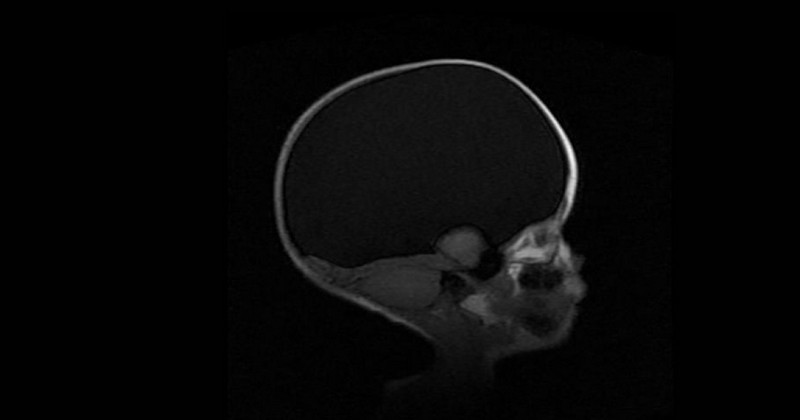Hydranencephaly: symptoms, causes and treatment

This serious malformation of the brain appears during gestation and its sequelae can be varied.
The development of our organism is somewhat complex. From the moment the sperm fertilizes the egg until we are born, there are multiple processes that take place and that generate our organs and body systems. The nervous system is one of the first to appear, along with the heart.The nervous system is one of the first to appear, along with the heart, and it will develop both during pregnancy and throughout life.
However, sometimes during gestation different problems occur that can cause the formation of our brain to fail. One of the multiple alterations that can occur is hydranencephaly, which we will discuss in this article..
What is hydranencephaly?
Hydranencephaly is defined as a type of congenital malformation consisting of the absence of practically the entire brain, specifically the cerebral cortex.The space generally occupied by the cerebral cortex is replaced by cerebrospinal fluid. Nevertheless, the shape of the subject's head may be normal, the cavities and meninges surrounding the skull being preserved. The cerebellum and brainstem are usually correctly formed and functional, with basic vital functions such as respiration and cardiac and Respiratory rhythms. Other subcortical structures may also be preserved.
The absence of the brain is due to the occurrence of some kind of destructive process during gestation, from the twelfth week onwards. In most cases, this will have severe repercussions, and these children will generally not be able to carry out the basic functions that such a structure would perform.
Although it may seem surprising due to the total or almost total absence of cerebral cortex, initially some of the children who are born with this problem may present an appropriate behavior and way of interacting with the world, being able to feed properly and not being diagnosed immediately. But generally, the existence of different alterations such as seizures, paralysis or alterations of the brain is observed. seizures, paralysis or sensory disturbances such as blindness or deafness.. They may present absence or slowing of growth, hypotonia or high irritability. The presence of some degree of psychic and physical disability is to be expected, requiring and depending on external care.
In most cases, the prognosis of children suffering from this disorder is very negative, with most of them dying before the age of one year. But there are also numerous cases in which, in spite of their condition, they manage to survive and even overcome adolescence and reach adulthood.
Hydranencephaly and hydrocephalus: differences.
It is important to keep in mind, as they are diagnoses that can be confused, that hydranencephaly and hydrocephalus are not the same.. Both disorders are similar in that there are large pockets of cerebrospinal fluid in the brain that occupy a large part of the skull, but while in hydrocephalus the excess fluid pushes on the brain tissue and at least some irrigated brain tissue can be observed, in hydranencephaly there is no such tissue at all.
The two disorders may be related, but it should be noted that hydranencephaly cannot be a consequence of hydrocephalus. What is possible is that hydranencephaly may end up causing hydrocephalus: the fluid that occupies the place of the brain may accumulate due to the production of more cerebrospinal fluid, causing an increase in intracranial pressure and/or protrusion of the skull.
Possible causes
Hydrocephalus is a congenital malformation whose causes may be multiple. Generally, as mentioned above, it is due to a destructive process affecting brain tissue during gestation.. This destruction can be caused by different elements, the most frequent being the existence of infarcts or strokes caused by the rupture of the internal carotid artery.
Other causes besides cerebrovascular accidents can be found in infection by different types of viruses or intoxication derived from the consumption of alcohol or drugs by the mother during fetal development. Finally, can be generated by diseases and genetic disorders..
Treatment
Hydranencephaly, as a congenital condition, currently has no curative treatment. This does not mean that no therapy can be used, although it will tend to be palliative. tend to be palliative and aimed at improving the patient's quality of life.. It is not infrequent that some type of drainage or derivation of the cerebrospinal fluid is performed to avoid possible hydrocephalus and joint damage.
It is also of great importance the treatment with the parents and the child's environment, requiring psychoeducation and counseling on the difficult situation of this disorder, as well as the risks that the baby will face. Attendance at support groups can also be very helpful, as well as psychotherapy to combat beliefs, fears and emotional disturbances generated by the diagnosis. generated by the diagnosis (and in some cases may experience disorders such as depression).
In cases of survival, the baby will require different supports and aids. The use of physiotherapy, speech therapy, training in basic daily living skills, special education and other professional care may be required.
Bibliographic references:
- Kinsman, S.L.; Johnston, M.V. (2016), Congenital anomalies of the central nervous system. In: Kliegman, R.M.; Stanton, B.F.; St.Geme, J.W.; Schor, N.F.. (eds). Nelson Textbook of Pediatrics. 20th ed. Philadelphia, PA: Elsevier;:chap 591.
- Marín, C.C. & Robayo, G. (n.d.). Hydranencephaly. Report of a case. Revista Colombiana de Pediatría , 40 (4).
(Updated at Apr 13 / 2024)